By Alex Trukan
Defending in and around the penalty box area is, alongside finishing, one of the two critical micro phases of the game. They are usually neglected and hoped they will ‘take care of themselves’. However, at the same time, it can be argued that these two phases are the two most important ones as the ability of the team to cope and excel in those phases, will often decide the final score of the game. Defending near the own goal has different priorities and requirements than defending on the opposition’s half or even in the middle third. Danger is much higher as any mistake can lead to conceding a goal, whereas rewards are lower due to relatively low chance of scoring quickly after regaining possession. Those two variables affect roles and responsibilities of the players involved in defending in and around the penalty box.
One of the first key requirements for the defending team around own box is to reduce the distances between each other and work as a compact block. Regardless of the shape, distances between the players should allow supporting player to immediately affect the ball in case the nearest player to the ball gets beaten. The team should stay together, travel together and arrive together in relation to the movement of the ball.
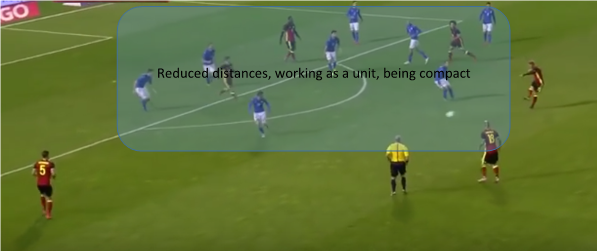
When the ball is near the penalty box, there is no time for delaying or waiting for the opponent to drive forwards. The spaces in front of the ball should be reduced immediately with no hesitation by applying pressure on the ball. In addition to that, the role of the supporting players is crucial as well, who should be able to intercept any passes into the penalty box as well as able to double up on the ball if needed. Scanning what’s in behind the supporting defender will allow him to see possible dangers. All of the players should look for the body position of the player on the ball, based on which they might be able to predict the next decision and intercept the ball.
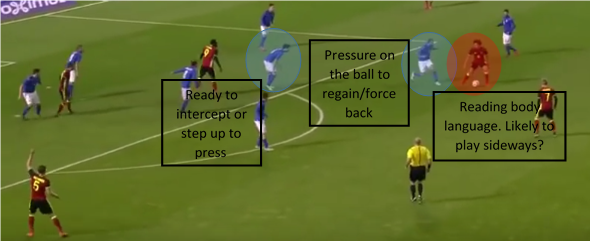
Players away from the ball should usually apply tight man to man marking within their zone. That would mean following the attacker tightly around defender’s position but passing him on if he moves into another zone nearby. Communication between defenders should be emphasised. The closer the opponent is to the goal, the tighter marking should be applied.
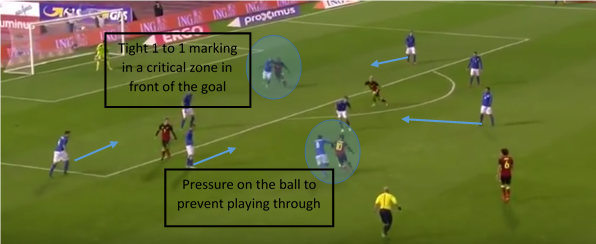
When defending in and around the penalty box, the team should remember that the highest priority is to prevent the opponents having any shots on goal and penetrating through the middle area (zone 14 in front of the goal). That is why, in most of the situations, forcing out wide should be applied. Once the ball is in the middle, the defending team would get compact in the central areas and leave the space on the wings (as shown on the diagrams above). As the ball is played into the wide area, the team should try to move as a unit and block any options into the middle, leaving options to stay wide or play back if possible. The role of the first defender is crucial who should apply pressure from inside-out and by his body position, angle of approach as well as position of supporting players, ‘show wide’. More detailed technical content shuch as information about weak/strong foot of the opponent as well as preffered players used in attack is more sophisticated but often there are not enough time to think and make a decision based on that around the penalty box. That is why, first defender should focus on easy to understand guidelines such as for example ‘get between the ball and the goal’, ‘block shots’ or ‘show wide’.
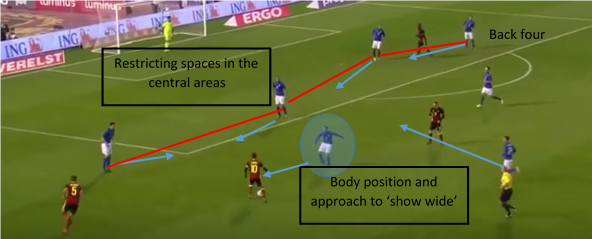
It is also important to recognise triggers and be able to apply tighter and more aggressive pressing if needed. One of the triggers might be a situation when the opponent is facing back or into side line. That would be a moment to try to isolate him in the wide area and win the ball back or force a back pass. As we can see below, it is not only the role of the nearest player to the ball but also supporting players who cut possible passing options and are able to double up if needed. Players away from the ball, inside the penalty box don’t need to mark tightly in this situation as there is no immediate threat of a cross.
[wpsharely id="2988"][/wpsharely]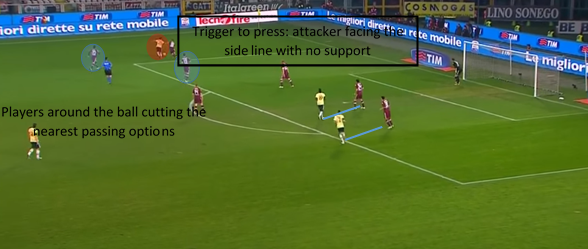
At times, the defending team will be disorganised around the own box (in example after a counter-attack). In this case, the main aspect to focus on would be managing risks and threats. More specifically, remembering that the goal is a highest priority to protect, players should first aim to get between the ball and the own goal, at the same time, delaying the attacker and applying pressure on the ball. Secondly, nearest players to the ball and forward runners should be tightly tracked. In addition to that, players away from the ball should aim to recover into ‘gaps’ which are left, trying to mark the players which potentially can receive the ball but are not an immediate threat.
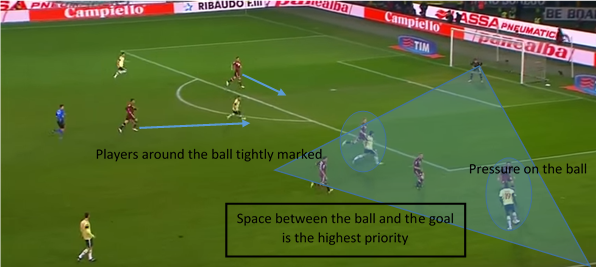
Apart from the technical and tactical content, defending in and around the penalty box should be based on clear and concise communication between the players. The commands should be easy to understand and apply i.e. ‘press’, ‘no cross’, ‘tight’, ‘no shot’, ‘delay’ or ‘force out’. Second important mental attribute would be concentration and discipline. Finally, players should have an attitude of urgency to get the ball away from the own goal as soon as possible.
By Alex Trukan, Development Coach, Nottingham Forest
@AlexTrukan


